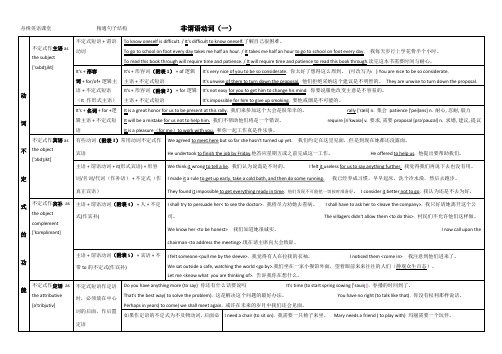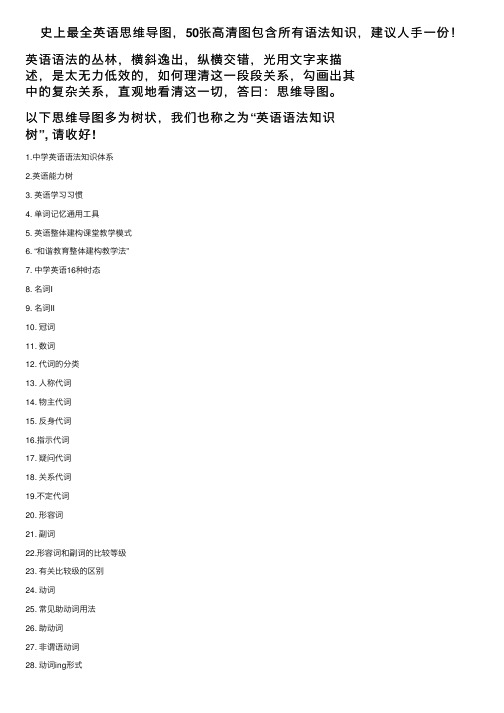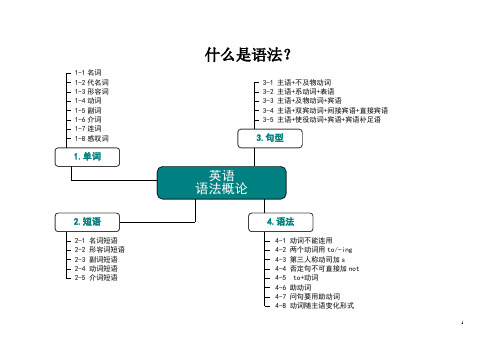01 不定式的句法功能 思维导图(改进版)
不定式的句法功能思维导图

舟楫英语课堂精通句子结构非谓语动词(一)
(附表1)适合“It's + 形容词 + of +逻辑主语 + 不定式短语”句型中的形容词
(附表2)适合“It's + 形容词 + for+逻辑主语 + 不定式短语”句型中的形容词
(附表3)常用动词不定式作宾语的动词
(附表4)常用于“主语 + 谓语动词 + 人 + 不定式(宾补)”句型中的动词:
(附表5)常用于“主语 + 谓语动词(附表5) + 宾语 + 不带to的不定式(作宾补)”句型中的动词:
(附表6)作表语的不定式短语通常是说明主语的内容,这时主语通常是表示目的愿望一类的名词
(附表7)适合“主语 + be动词 + 形容词 + 不定式”句型中的形容词, 带星号的形容词后面常接:to see, to learn, to discover, to find out, to hear。
50张思维导图搞定所有英语语法知识

50张思维导图搞定所有英语语法知识
英语学习中,语法无疑是一个重难点,今天为大家收集了50张英语学习思维导图,大家一定要仔细看哦~
01中学英语语法知识体系
02英语能力树
03英语学习习惯
04单词记忆通用工具
05英语整体建构课堂教学模式
06和谐教育整体建构教学法
07中学英语16种时态
08名词I
09名词II
10冠词
11数词
12代词的分类
13人称代词
14物主代词
15反身代词
16指示代词
17疑问代词
18关系代词
19不定代词
20形容词
21副词
22形容词和副词的比较等级
23有关比较级的区别
24动词
25常见助动词用法
26助动词
27非谓语动词
28动词ing形式
29不定式的时态和语态
30省to的动词不定式
31不定式作宾语
32不定式作补语
33不定式作主语
34
不定式语法功能
35doing和to do的区别1
36doing和to do的区别2
37分词
38独立主格结构
39一般现在时
40一般将来时
41现在完成时
42一般过去时
43现在进行时
44时态与时间状语
45被动语态
46各种形式的被动语态
47句子的种类
48反意疑问句
49反意疑问句记忆规则1
50反意疑问句记忆规则2。
02不定式的形式变化思维导图(改进版)(可编辑修改word版)

Last summer I took a course on how tomakedresses去年夏天我参加了一个服装制作课程。
No one told him what to do.没有人告诉他该做什么。
Have you decided when to leave?你决定什么时候动身了吗?
作表语
The article is too difficult [for a child of ten to understand].这篇文章太难,是一个十岁的孩子理解不了的。
作定语
The order(for them to climb the mountain)wasgiven.让他们登山的命令已经发出。
疑问代词who, what, which和疑问副词when, where, why等后面加上不定式,构成的一种不定式短语
作主语
When and where to build a new factoryis notdecided yet.什么时候、在哪里建新工厂,还没有决定。
How to beginis the problem.怎么开始是个问题。
5.havenothingto dobut do sth.只能做…When youhaveonce made your capital, youhave nothingto do butemploy it.一旦资金捞到手,你就万事大吉,只有尽量运用就是喽。
6.Whynot dosth?为什么不做…?So, if you're waiting fortomorrow,why not doit today?那么,如果你在等待明天,为什么不在今天付诸行动呢?
不定式的主动语态的时态形式
一般式
aa.不定式的句法功能 思维导图

不定式短语作定语时,必须放在中心词的后面,作后置定语
Do you have anything more(to say)?你还有什么话要说吗?It's time(to start spring sowing['səuiŋ]).春播的时间到了。That's the best way(to solve the problem).这是解决这个问题的最好办法。You have no right(to talk like that).你没有权利那样说话。Perhaps in years(to come)we shall meet again.或许在未来的岁月中我们还会见面。
It's +形容词(附表1)+ of逻辑主语+不定式短语
It's very niceof you to be so considerate.你太好了想得这么周到。(可改写为:) You are nice to be so considerate.It's unwiseof them to turn down the proposal.他们拒绝采纳这个建议是不明智的。They are unwise to turn down the proposal.
不定式作表语as the predicative['predi.keitiv]
作表语的不定式短语通常是说明主语的内容,这时主语通常是表示目的愿望一类的名词(附表6)。
The purpose of new technologies isto make life easier, not to make it more difficult.新技术的目的是使生活更便利,而不是更繁琐。Her wish isto become a singer.她的愿望是当一名歌手。Our plan isto finish the work in two weeks.我们的计划就是在两星期内完成这项工作。
05-不定式过去分词动词ing形式之功能比较-思维导图(改进版)

I saw him fall down from the bike. 我 看 到 他 从 自 行 车 上 摔 下 来 。 ( 已 经 完 成 的 动 作 , 动 作 的 全 过 程 )
We heard him cry out. 我们听见他大喊一声。(已经完成的动作,动作的全过程)
Let me see. / Let me think. 让我想一想。 Let sb. go 放,释放某人。 Let yourself go. 放松,随心所欲,不修边幅
love
like
hate
prefer
dislike
喜爱
喜欢
憎恨
更喜欢
厌恶
can't bear
propose
want
need
remember
不能忍受
建议
想要
需要
记得
love, like, dislike, prefer, propose, I dread being sick. 我特别害怕生病。
dread, can't bear, 等动词 接 ing I dread to think what would happen if there really were a fire here.
To see is to believe.
表示泛指意义的动作
My hobby is growing flowers. 我的爱好是种花。
Seeing is believing. 眼见为实。
作目的状语 They ran over [to welcome the delegates]. 他 作结果状语 He woke up [to find everybody gone]. 他醒了 作原因状语 We all rejoiced [ri'dʒɔisd]
初中英语动词不定式todo用法图示及举例说明(考试必备宝典)

初中英语动词不定式todo用法图示及举例说明(考试必备宝典)1、不定式的形式以动词do为例式|语态主动语态被动语态一般式 to do (主动, 未发生) to be done (被动, 未发生)完成式 to have done (主动, 已完成) to have been done (被动, 已完成)进行式 to be doing (主动, 正在进行)完成进行式 to have been doing (主动, 完成进行)不定式的形式2、不定式的句法功能(1)不定式作主语To hear from you is good. 收到你的来信很好To be a good student is not easy. 做一个好学生不容易不定式作主语时,为了保持句子的平衡,往往以it作形式主语,不定式作为真正主语置于谓语动词后。
如:It’s good to hear from you.It’s not easy to be a good student.(2)不定式作宾语通常用于want, hope, wish, like, need, hate, begin, start, remember, agree, learn, refuse, manage, help等词后。
如:I forgot to close the door. 我忘记关门了Please remember to write to me. 请记得给我写信(3)不定式作表语My job is to pick up litters. 我的工作是捡起那些乱丢的垃圾He seemed to have heard something. 他看起来似乎听说了一些事(4)不定式作定语不定式作定语时,须放在它所修饰的名词或代词后。
如:I have a lot of letters to write. 我有很多信要写I have a lot of homework to do. 我有很多作业要做(5)不定式作宾补通常用于want, wish, ask, order, tell, know, help, advise, allow, cause, force等词后。
高二英语人教版(2019)选择性必修第三册思维导图

动词不定式(短语)作表语动词不定式(短语)作表语的用法动词不定式(短语)作表语省略t o的情况动词不定式(短语)作表语和动词-ing(短语)作表语的区别主语是以aim, suggestion, duty, hope,i dea, intention, plan, purpose, the wayt o do sth. 等为中心的名词词组时,或者以w hat引导的名词性分句表示,一般用动词不定式作表语说明主语的内容。
表示目的。
a ll作主句主语,其后的定语从句中含有实义动词do的某种形式时。
表示事态发展的结果、预期的结果、不幸的命运或预言。
用于被动语态,相当于can/could,should,o ught to,must,具有情态意义。
表示”同意、安排、命令、决定、劝告、愿望、意愿、禁止"等。
动词不定式(短语)作表语时,可用主动形式表示被动意义。
w hat引导的从句作主语,从句中含有实义动词do的某种形式时。
(主句)主语被 only,first,one,least或形容词最高级修饰,且其后作定语的从句或短语中含有实义动词do的某种形式时。
动词不定式(短语)和动词-ing(短语)作表语时,要注意与句子的主语在形式上保持一致,即若句子的主语为动词-ing(短语),则表语也应使用动词-i ng(短语),若主语为动词不定式(短语),则表语也应使用动词不定式(短语)。
动词不定式(短语)和动词-ing(短语)作表语时可换用,但以下情况除外:当动词所表达的是某一特定的行为,尤其是将来的行为或有待于实现的行为时,通常用动词不定式(短语)作表语。
若动词所表达的并不强调动作,而是表示主语的内容,则通常用动词-ing(短语)作表语。
动词不定式(短语)作主语用作主语的动词不定式(短语)常出现在谓语动词之后,这时需在句首用形式主语It指代它。
其句型有2种:"疑问词+动词不定式(短语)"结构I t+v.+宾语/表语(+for sb.)+to do sth.I t+v.+表语+of sb.+to do sth.(表语常为表示人的性格、品质的形容词,如g ood,kind,nice,foolish,polite,c lever,careless等。
第十二章动词不定式(思维导图+知识梳理+好题精炼)2022-2023初中英语中考语法归纳

第十二章动词不定式思维导图知识梳理一、不定式概述动词不定式的基本形式是:“to+动词原形”,有时可以不带to.不带to的不定式与动词原形同形,但它不是原形,而是一种语法形式.除基本助动词do和情态动词外,英语动词都有不定式形式.动词不定式没有人称和数的变化,在句子中不能作谓语,但可以担任除谓语外的任何成分-主语、表语、宾语、定语、状语和宾语补足语.动词不定式和它的宾语或状语构成不定式短语.不定式有时态、语态变化(以do为例):主动语态被动语态一般式to do to be done进行式to be doing-完成式to have done to have been done 完成进行式to have been doing-动词不定式的句法作用(一)作主语用作主语的动词不定式通常表示一种具体的、特定的行为,其谓语动词用第三人称单数形式.To obey the laws is everyone's duty.服从法律是每个人的职责.How to use the computer is a question.怎么使用计算机是一个问题.How to get there is not decided yet.怎样去那里还没决定下来.点拨(1)在很多情况下,常用it作形式主语,而把真实主语不定式放在谓语之后.It was difficult to sell my car.我的车很难卖掉.It's not known where to stay for the night.在哪里过夜还不知道.(2)如果要表示不定式的动作是谁做的,一般在不定式前加一个for短语.It will be a regret for us not to help him.我们没有帮助他是个遗憾.(3)在某些形容词(如kind,good,nice,wise,unwise,clever,silly,wrong,right,foolish,stupid,careless, considerate,rude,naughty,impolite等)作表语时,不定式前常可加一个以of引起的短语,来说明不定式指的是谁的情况.It would be rude of us to refuse their invitation.(我们)拒绝他们的邀请,会显得无礼.(二)作表语作表语,一般紧跟在系动词,如:be,seem,get等后面,用以说明主语.The question is when to start.问题是什么时候启程.You seem to have lost weight.你好像减肥了.What we have to do first is to find a solution.我们得做的第一件事是找出一个解决办法.点拨当不定式所作的表语仅用来说明主语的内容时,这个不定式只作单纯的表语,而不具有未来的含义.(三)作宾语能以不定式作宾语的动词很多,常见的有:agree,begin,decide,expect,forget,hope,learn,like,manage, pretend,start,try,want,wish等.Do you wish to see the manager?你想见经理吗?They decided to learn English hard.他们决定好好学英语.Don't forget to meet me at6:00.别忘了六点钟和我见面.有些动词,如:tell,advise,show,teach,know,forget,learn,remember,show,understand,see,wonder,hear, find out,explain,decide,discuss等后面,常用带疑问词的不定式作宾语.We don't know who(whom)to ask.我们不知道问谁.We asked how to get to the station.我们问怎么到达车站.Have you decided where to go for your holidays?你们决定到哪儿度假了吗?I don't know whether to apply for the job or not?那份工作我不知道申请还是不申请?(四)作定语I have no time to waste.我没有时间可浪费.Let me find a place to park.我来找个停车的地方.He is always the first to come to work and the last to leave.他总是第一个来上班,最后一个走.点拨不定式修饰something,anything,nothing时,放在它们的后面.如果something,anything,nothing有形容词来修饰,词序是something(nothing...)+形容词+不定式.My father had something to do.我父亲有事要办.Have you got anything important to buy?你有什么重要的东西要买吗?(五)作状语不定式常可用作状语,修饰动词,表示行为的目的、结果、原因等.一般放在被修饰词之后,但在表示目的时,为了强调也可放在句首.1.作目的状语为加强语气在否定式前还可加上in order或so as组成词组(即:in order to...,so as to...),作状语表示目的.To live a long and healthy life,we must learn to have a balanced diet.为了能过长寿而健康的生活,我们必须懂得吃均衡的食品.I stayed there so as to see what would happen.我留在那儿,为的是想看看会发生什么事.In order to help him,we would do everything we can.为了帮助他,我们愿意尽一切力量.2.作结果状语表结果,其逻辑主语通常亦是全句的主语.在“so...as to...”“such...as to..“enough to...”“only to...”以及“too...to...”等结构中的不定式皆表示结果.She is old enough to go to school.她已到了可以上学的年龄了.He was too drunk to drive home.他酩酊大醉,没法开车回家.3.作原因状语She trembled to think of the terrible accident.想到那可怕的车祸,她就不寒而栗.We jumped with joy to hear the news.听到这消息,我们都高兴地跳了起来.(六)宾语补足语1、有很多动词的后面都可以有不定式作宾语补足语常见的这类动词有:advise,ask,tell,help,wish,want, expect,forbid,persuade,press,request,teach,warn等.She asked her grandfather to play game with her.她请爷爷跟她一起做游戏.Mother told me to cook the meal.妈妈叫我做饭.2.有一些动词后用作宾语补足语的不定式通常不带to,这种动词有两类:一类是感觉动词,另一类是使役动词感觉动词:如feel,see,hear,watch,notice等.使役动词:如make,let,have等.Let me do it for you.让我来替你做.Don't let her go out.别让她出去.I made him work hard.我迫使他加劲干.(1)动词help之后,复合宾语中的不定式可带to,亦可不带to.在上述动词转换为被动结构时,其后的不定式必须带to.He was seen to enter the theatre.有人看见他走进了剧院.I was made to do my homework the whole night.我被迫整晚做作业.Can you help me(to)move this table?你能帮我移动一下这张桌子吗?(2)感官动词的宾语补足语有两种形式:不带to的不定式和动词-ing形式.I heard Meimei singing in her room when I went past.我路过的时候听见梅梅在房间里唱歌.(路过的瞬间正在唱,所以用singing)We often hear Meimei sing in her room.我们经常听见梅梅在房间里唱歌.(经常听见,用不定式)I saw him come in.I saw him coming in.两句话的意思都一样:我看见他进来.用不定式着重于动作的全过程,用动词-ing形式则是强调当时动作的进行情况.3.当谓语动词为think,make,find,consider,feel,regard等词,作宾语的不定式后面有宾语补足语时,常用it作形式宾语,而将真正的宾语放在补足语的后面I find it easy to learn English well.我发现要把英语学好很容易.三、不定式的主要句型及注意事项(一)不定式的否定式不定式的否定式:not+不定式,经常和ask(tell)sb.to do sth.句型连用.She asked me not to drive him to the station.她要我不要开车送他到车站.Try not to be late.争取不要迟到.Mary asked me not to give my pen to Jimmy.玛丽让我别把笔给吉米.She decided not to come here again.她决定不再到这儿来.点拨不定式的否定式和否定句的区别:I asked him not to open the door.我让他别把门打开.I didn't ask him to open the door.我没让他把门打开.(二)不定式的进行时态进行式:表示在谓语动词所表示的动作或状态发生时正在进行.It's nice to be sitting here with you.在这儿陪你坐着是非常愉快的.It is unwise for him to be talking that topic all the time.他老是谈论这件事,很不明智.(三)不定式的完成时态完成式表示在谓语动词的动作或状态发生时已经完成.She said she was sorry to have missed you.她说她没见到你很遗憾.He seemed to have visited our factory.他好像参观过我们的工厂.They appeared to have met before.他们看来以前见过面.(四)动词不定式的被动语态表示被动意义I didn't want to be told about it.我不想被告知这件事.Nothing seems to have been forgotten.似乎什么也没有被遗忘.The building is said to have been destroyed in a fire two years ago.据说这幢大楼两年前已毁于一场大火.在以某些形容词,如kind,good,silly,honest,bad,stupid,bold,clever,cruel,courteous,nice,rude,sensible, tactful,wise,wrong等作表语时,后面需用以“of+名词(或代词宾格)+不定式”结构,以说明不定式所表示的动作的执行者是谁(即of短语是不定式的逻辑主语).It's very good of you to come.谢谢你的光临.How silly of you(it is)to make such a mistake!你出了这样的差错,多傻啊!It's very kind of you to say so.多谢你这么说.在had better,had best,would rather,would rather...than,would sooner,would sooner...than,cannot but,do nothing but等结构后面的不定式要省略“to”.You had better write it in English.你最好用英文写.I would rather stay at home.我宁愿待在家里.好题精练一、用-ing形式或不定式的适当形式完成句子1.Do you enjoy_________football?(play)2.Fred didn't have any money,so he decided_________a job.(take)3.We're going out for dinner,Would you like_________us?(join)4.The teacher reminded the students_________their test paper on time.(finish)5.When I was tired,I enjoyed_________TV.(watch)6.It was a nice day,so the old man agreed_________for a walk.(go)7.I'm not in a hurry,I don't mind_________.(wait)答案:1.playing2.to take3.to join4.to finish5.watching6.to go7.waiting二、选择括号内所给词组完成句子,注意括号内“go+v.-ing形式”构成固定搭配的用法(go boating;go fishing;go dancing;go running;go skating;go hunting;go singing)1.She's a good dancer.She always_________on Saturday.2.I've got a gun.I'll_________with that strong hunter next weekend.3.“Where is Tim?”“He has._________He always runs in the morning.”4.We have enough fish to eat.Our father_________every day.答案:1.goes dancing2.go hunting3.gone running4.goes fishing三、仿照示例改写下列句子示例:It is very interesting to play baseball.→To play baseball is very interesting.1.lt was not polite to speak that way before Mr.Lee.____________________________________________________________________________________________ 2.It can be quite easy to travel by air.____________________________________________________________________________________________ 3.lt will be no problem to arrive there before noon.____________________________________________________________________________________________4.To make those strangers believe us was so difficult.____________________________________________________________________________________________ 5.To help Tom speak Chinese well is not at all easy.____________________________________________________________________________________________答案:1.To speak that way before Mr.Lee was not polite.2.To travel by air can be quite easy.3.To arrive there before noon will be no problem.4.It was so difficult to make those strangers believe us.5.It is not at all easy to help Tom(to)speak Chinese well.四、选择填空1._________the bookstore,he stopped_________a few books.A.Passing;buyingB.Passing;to buyC.To pass;buyingD.Having passed;to buy2.Bruce,look at your dirty shoes,You'd better_________them right now.A.washedB.washingC.washD.to wash3._________the room,I found the computer_________.A.Entering;stealingB.Entering;stolenC.To enter;stealD.To enter;stealing4.We've worked hard for nearly one hour.Let's stop_________a rest now.A.haveB.to haveC.havingD.have had5.My mother always tells me not_________to the net bars(网吧).A.goB.to goC.goesD.going6.The teacher asked us_________English for half an hour in the morning.A.reads B reading C.to read D.read7.You will have to get up early tomorrow.Stop_________TV,Peter.A.watchesB.watchC.to watchD.watching8.I find it hard_________English well.A.learnB.learningC.to learnD.learns9.The teacher asked John_________a short talk in our class meeting.A.giveB.to giveC.gaveD.giving10.The girl was too poor_________a houseA.to buy;to live inB.to buy;to liveC.buy;to liveD.buying;living in11.It was very late at night,but Mr.Brown still went on_________.A.worksB.workedC.workingD.work12.Remember_________him about it before he goes away.A.tellB.to tellC.tellingD.to telling13.Lin Tao is strong enough_________the big box.A.carryB.to carryC.carryingD.carries14.Her mother told her_________in bed.A.not readB.not to readC.don't readD.to not read15.When class began,we stopped_________to the teacher carefully.A.listeningB.listenC.listensD.to listen16.You'd better_________the cinema by bus.A.don't goB.to goC.to go toD.go to17.What did the manager_________you to_________at the meeting?A.tell;sayB.ask;speakC.tell;speakD.ask;talk18.Tom was let_________in the gate house.A.waitB.to waitC.waitingD.to have waited19.Mr.Hu has enough time_________the job in two days.A.finishB.to finishC.finishingD.finished20.Look,the building_________is our library.A.is repairedB.being repairedC.repairingD.to be repairing21._________no money,I could not buy this coat.A.HaveB.HavingC.To haveD.Have had22.The teacher has something important_________us.A.to tellB.tellsC.tellingD.told23.Li Ming didn't know_________next.A.to do whatB.what to doC.how to doD.what do24.I'd love_________to your birthday party.eB.cameC.to comees25.It took me two hours_________by bus.A.to get thereB.to get to thereC.get thereD.get to there答案:1-5BCBBB6-10CDCBA11-15CBBBD16-20DABBB21-25BABCA五、改正下列句子的错误1.He seems to not hear from her.____________________________________________________________________________________________ 2.I hope see you soon.____________________________________________________________________________________________ 3.I made them to give the money back.____________________________________________________________________________________________ 4.The scientist gave us some advice on how learning English.____________________________________________________________________________________________ 5.No one noticed him to leave the room.____________________________________________________________________________________________ 6.Have you given up to smoke?____________________________________________________________________________________________ 7.We found him waited at the school gate.____________________________________________________________________________________________ 8.Why not to turn off the light?____________________________________________________________________________________________ 9.She didn't want me go.____________________________________________________________________________________________ 10.I don't know to swim.____________________________________________________________________________________________ 11.China is a developed country belonging to the third world.____________________________________________________________________________________________ 12.It's getting dark.We have to find a hotel to live.____________________________________________________________________________________________ 13.He said he had an important meeting to attended.____________________________________________________________________________________________ 14.They don't allow that people smoke.____________________________________________________________________________________________ 15.It's difficult sell my car.____________________________________________________________________________________________答案:1.He seems not to...2.I hope to see...3.I made them give...4....how to learn...5....him leave...6....given up smoking?7...him waiting...8.Why not turn off...9.She didn't want me to go.10.I don't know how to swim.11....a developing...12....to live in13....to attend.14....people to smoke.15...to sell my car.。
史上最全英语思维导图,50张高清图包含所有语法知识,建议人手一份!

史上最全英语思维导图,50张⾼清图包含所有语法知识,建议⼈⼿⼀份!英语语法的丛林,横斜逸出,纵横交错,光⽤⽂字来描述,是太⽆⼒低效的,如何理清这⼀段段关系,勾画出其中的复杂关系,直观地看清这⼀切,答⽈:思维导图。
以下思维导图多为树状,我们也称之为“英语语法知识树”, 请收好!1.中学英语语法知识体系2.英语能⼒树3. 英语学习习惯4. 单词记忆通⽤⼯具5. 英语整体建构课堂教学模式6. “和谐教育整体建构教学法”7. 中学英语16种时态8. 名词I9. 名词II10. 冠词11. 数词12. 代词的分类13. ⼈称代词14. 物主代词15. 反⾝代词16.指⽰代词17. 疑问代词18. 关系代词19.不定代词20. 形容词21. 副词22.形容词和副词的⽐较等级23. 有关⽐较级的区别24. 动词25. 常见助动词⽤法26. 助动词27. ⾮谓语动词28. 动词ing形式29. 不定式的时态和语态30. 省to 的动词不定式31. 不定式作宾语32. 不定式作补语33. 不定式作主语34. 不定式句法功能35. doing与to do的区别136. doing与to do的区别237. 分词38. 独⽴主格结构39. ⼀般现在时40. ⼀般将来时41. 现在完成时42. ⼀般过去时43. 现在进⾏时44. 时态与时间状语45. 被动语态46. 各种形式的被动语态47. 句⼦的种类48. 反意疑问句49. 反意疑问句记忆规则150.反意疑问句记忆规则2。
(完整版)高中英语语法知识思维导图

什么是语法?+表语+宾语+间接宾语+直接宾语+宾语+宾语补足语to/-ingsnot一般现在时vs.一般过去时一般将来时将来时表示将来某个时间要发生的动作或存在的状态,也表示将来经常或者重复发生的动作,常与表示将来的时间副词连用,例如:soon,next week, this afternoon,tomorrowWe will graduate next year.我们明年毕业。
进行时(1)(V+ing)现在分词(V+ing)现在分词(V+ing)?进行时(2)完成时(1)Part1 完成时的句型构成1-1 陈述句型:S+has/have+过去分词(p.p.)I have already finished my homework.(我已经完成了我的作业) 1-2 否定句型:S+has/have+not+过去分词(p.p.)Sandy has been a nurse in this hospital for 15 years.(珊蒂已经在这家医院担任护士长达15年了。
) 1-3 疑问句型:Has/Have+s+过去分词(p.p.)?Have you ever seen Peter in past 3 months?(过去3个月内,你看见过彼吗?)2-1 陈述句型:S+had+过去分词(p.p.)This proposal had been deliverde by Eva before Aaron finished it. (这个计划在艾伦完成以前,伊娃就已经提交出去了) 2-2 否定句型:S+had+not+过去分词(p.p.)I had not finished my work when he visited me last week.(上周他来拜访我以前,我还没有完成工作。
) 2-3 疑问句型:Had+s+过去分词(p.p.)?Had you ever been to a blind date before you married?(你结婚以前曾经参加相亲吗?)3-1 陈述句型:S+shall/will+have+过去分词(p.p.)They wll have finished the meeting by now. (他们现在应该已经开完会了) 3-2 否定句型:S+shall/will+have+not+过去分词(p.p.)We will have not made 10 apple pies by the end of today.(我们在今天结束之前不能做完10个苹果派。
同步语法思维导图-Unit 2 不定式

同步语法思维导图-Unit 2 不定式【知识导图】【要点拓展】1.动词(短语)用作介词宾语时通常要用v.-ing形式,但but与except等词后要接动词不定式(短语)。
如果but和except前有实义动词do,不定式(短语)的to通常要省去。
I have no choice but to stay here. 我别无选择只能留在这里。
He did nothing last Sunday but repair his bike. 上星期天他除了修理他的自行车外什么也没做。
(but前有实义动词did,因此不定式短语不带to)2.不定式(短语)作动词find、think等的宾语,常用it作形式宾语,而将真正的宾语放在句末。
I thought it best to call first. 我认为最好还是先打个电话。
3.在表示感官、使役等意义的动词(短语)后,要用不带to的不定式(短语)作宾语补足语。
常见的:这类动词(短语)有feel、hear、listen to、see、watch、look at、notice等。
但是,句子是被动语态时,不能省略to。
She heard Tom go upstairs. 她听见汤姆上楼了。
The workers are made to work 12 hours a day. 工人们被迫一天工作12小时。
She was seen to read under the tree. (有人)看见她在树下看书。
4.不用不定式(短语)作宾语补足语的动词有hope、agree、demand、suggest、insist等。
我希望你早点来。
【误】I hope you to come earlier.【正】I hope you come earlier.【奇思巧计】不定式有标记,to与动词连一起。
没有人称数变化,动词特点它具备。
主宾定状表补语,唯独作谓不可以。
not加上不定式,否定结构要牢记。
非谓语动词思维导图

非谓语动词思维导图1.在使用感官动词和使役动词时,常常使用“动词+宾语+do”结构,其中包括feel、hear、listen to、make、let、have、see、look at、watch、notice和observe等。
例如,It is right to give up smoking。
2.不定式可以用作主语、表语、宾语和宾语补足语,例如The XXX和XXX go。
3.一些动词可以使用“动词+宾语+to do+形容词或名词”结构,包括believe、consider、count、declare、deny、feel、find、guess、imagine、judge、know、prove、realize、suppose和think等。
例如,XXX。
4.不定式还可以用作状语和独立成分,例如To tell the truth。
I don't agree with you。
5.一些动词可以使用“动词+宾语+to do”结构,包括advise、allow、ask、beg、cause、challenge、XXX、dare、determine、direct、discover、drive、enable、expect、encourage、forbid、force、get、inform、invite、oblige、order、permit、persuade、prepare、mend、remind、request、require、send、teach、urge、want、warm和wish等。
6.不定式还可以用作目的状语、结果状语、条件状语和原因状语,例如I saw him go out、I plan to attend the meeting tomorrow、If you want to succeed。
you must work hard和Heleft to avoid an argument。
- 1、下载文档前请自行甄别文档内容的完整性,平台不提供额外的编辑、内容补充、找答案等附加服务。
- 2、"仅部分预览"的文档,不可在线预览部分如存在完整性等问题,可反馈申请退款(可完整预览的文档不适用该条件!)。
- 3、如文档侵犯您的权益,请联系客服反馈,我们会尽快为您处理(人工客服工作时间:9:00-18:30)。
动
词
不
定
式
的
功
能
不定式作主语as the subject['sʌbdʒikt]
不定式短语+谓语动词
To know oneselfis difficult./It's difficultto know oneself.了解自己很困难。
To go to school on foot every daytakes me half an hour./Ittakes me half an hourto go to school on foot every day.我每天步行上学花费半个小时。
It's +形容词(附表1)+ of逻辑主语+不定式短语
It's very niceof you to be so considerate.你太好了想得这么周到。(可改写为:) You are nice to be so considerate.It's unwiseof them to turn down the proposal.他们拒绝采纳这个建议是不明智的。They are unwise to turn down the proposal.
不定式作宾语as the object['ɔbdʒikt]
有些动词(附表3)常用动词不定式作宾语
We agreedto meet herebut so far she hasn't turned up yet.我们约定在这里见面,但是到现在她都还没露面。He undertookto finish the job by Friday.他答应星期五或之前完成这一工作。He offeredto help us.他提出要帮助我们。
I'm glad to meet you.见到你很高兴。
(附表1)适合“It's +形容词+ of+逻辑主语+不定式短语”句型中的形容词
kind善良的,仁慈的
good好的,上等的
nice友好的,令人愉快的
wise明智的,有见识
unwise不聪明的
clever聪明的,灵巧的
silly可笑的,犯晕的
wrong有毛病的
不定式作状语as the adverbial[əd'və:biəl]
作目的状语
They ran over[to welcome the delegates].他们跑过去欢迎代表们。We must do everything we can[to help them].我们要尽一切力量帮助他们。They went there[to visit their teacher].他们去那里拜访他们的老师。[To explain more clearly], I'll show you the pictures.为了解释得更清楚,我给你们看一些图片。in order to/ so as to也可以用来引起目的状语Tom kept quiet about the accident,[so as not to lose his job].为了不至于丢掉饭碗,汤姆闭口不谈事故的事。
make
let
see
watch
hear
have
feel
notice
listen to
使得
让
看见
注视
听见
使
觉得
注意到
听
(附表6)作表语的不定式短语通常是说明主语的内容,这时主语通常是表示目的愿望一类的名词
hope
idea
job
plan
wish
aim
purpose['pə:pəs]
thing
To read this book throughwill require time and patience./Itwill require time and patienceto read this book through.读完这本书需要时间与耐心。
It's +形容词+ for/of+逻辑主语+不定式短语(It作形式主语)
Would you be so kind[as to do me a favour]?请你帮我一下好吗?Her madness is not such[as to fill her mother with despair].她还没有疯到令其母亲绝望的程度。The boy is old[enough to take care of himself].这个男孩够大了,可以自己照顾自己。She returned[only to find that no one was at home].她回到家,才发现家里没有一个人。
作原因状语
We all rejoiced[ri'dʒɔisd] [to hear of your success].听说你们成功了我们很高兴。He shuddered[to think of his bitter past].他每当想起辛酸的过去就不寒而栗。
主语+ be动词+形容词+不定式这种句型中的主语通常是人,形容词(附表7)多半是描述此人的态度或情感状况。
illegal[i'li:gəl]不合法的
immoral[i'mɔ:rəl]不道德
unfair不公平的
unhealthy不卫生的
unjust不公平的
unlawful非法的
(附表3)常用动词不定式作宾语的动词
agree同意
ask要求
attempt企图
begin开始
care在乎
choose选择
continue继续
主语+谓语动词+ it(形式宾语)+形容词/名词/代词(作补语)+不定式(作真正宾语)
We thinkitwrongto tell a lie.我们认为说谎是不对的。I feltituselessfor us to say anything further.我觉得我们再说下去也没有用。I madeita ruleto get up early, take a cold bath, and then do some running.我已经养成习惯,早早起床,洗个冷水澡,然后去跑步。They founditimpossibleto get everything ready in time.他们发现不可能把一切按时准备好。I consideritbetternot to go.我认为还是不去为好。
作结果状语
What have I said[to make you so excited]?我说了什么使你这么激动?He woke up[to find everybody gone].他醒了过来,结果发现大家都走了。以下结构,可以用来引起结果状语:so...as to/ such... as to/ enough to/ only to/ too...to
decide决定
desire向往
determine决心
expect期待
forget忘记
hate厌恶
hope希望
intend打算
learn学会
like喜欢
love喜爱
manage做成
mean打算
offer提出
prefer宁可
pretend装作
promise允诺
undertake答应
start开始
try尝试
主语+谓语动词(附表5)+宾语+不带to的不定式(作宾补)
I felt someone<pull me by the sleeve>.我觉得有人在拉我的衣袖。I noticed them <come in>我注意到他们进来了。We sat outside a cafe, watching the world <go by>.我们坐在一家小餐馆外面,望着眼前来来往往的人们(静观众生百态)。Let me<know what youarethinking of>.告诉我你在想什么。
foolish荒谬的
stupid笨拙的
careless草率的
right正确的
rude粗鲁的
naughty顽皮的
impolite不礼貌的
considerate[kən'sidərit]考虑周到的
(附表2)适合“It's +形容词+for+逻辑主语+不定式短语”句型中的形容词
costly['kɔstli]代价高的
It's +形容词(附表2)+ for逻辑主语+不定式短语
It's not easyfor you to get him to change his mind.你要说服他改变主意是不容易的。It's impossiblefor him to give up smoking.要他戒烟是不可能的。
It's +名词+ for+逻辑主语+不定式短语
不定式作定语as the attributive[ə'tribjutiv]
不定式短语作定语时,必须放在中心词的后面,作后置定语
Do you have anything more(to say)?你还有什么话要说吗?It's time(to start spring sowing['səuiŋ]).春播的时间到了。That's the best way(to solve the problem).这是解决这个问题的最好办法。You have no right(to talk like that).你没有权利那样说话。Perhaps in years(to come)we shall meet again.或许在未来的岁月中我们还会见sh想要
